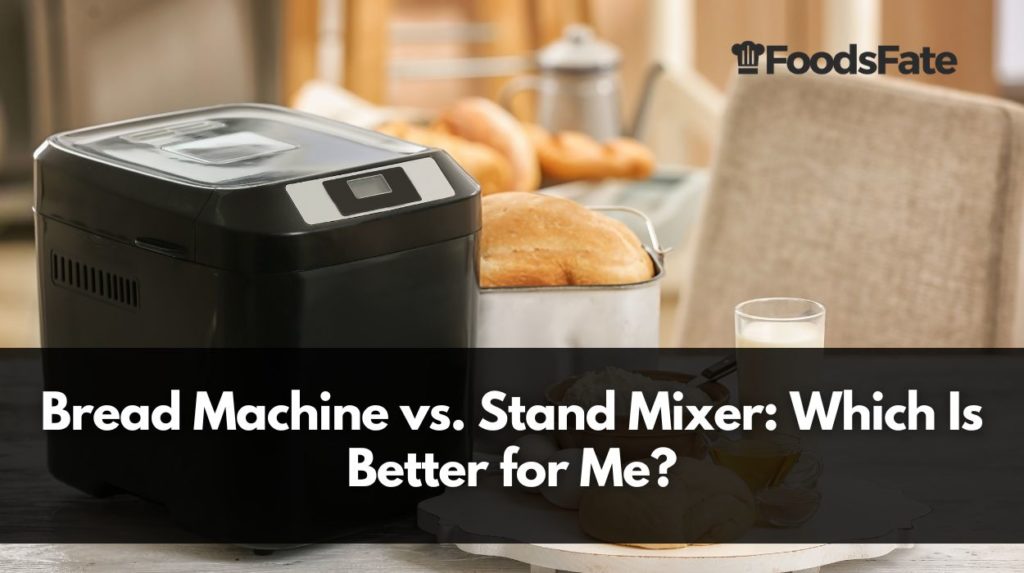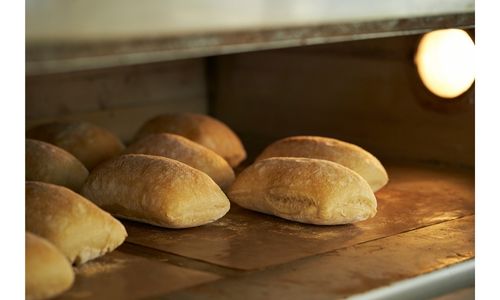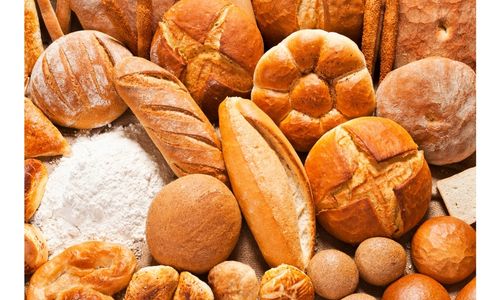
Are you confused between purchasing a bread maker or a stand mixer? Are you also influenced by Instagram and want to make your dough? Well, let us help!
A bread maker is fantastic if you want a single device that can mix and bake your dough. A stand mixer is a machine that uses electricity to mix and blend various ingredients. The only distinction is that raw ingredients are baked in a bread machine while combined in a stand mixer.
To help you make an educated decision, we have compiled this article that discusses both the appliance’s pros and cons. We have also added a comparative analysis between the two!
| Bread Machine | Stand Mixer | |
|---|---|---|
| Cost | Generally less expensive | Generally more expensive |
| Size and weight | Smaller and lighter | Larger and heavier |
| Bread-making capabilities | Specialized for making bread | Can make bread, but not specialized |
| Mixing capabilities | Limited mixing capabilities | Wide range of mixing capabilities |
| Kneading capabilities | Can knead dough | Can knead dough |
| Available attachments | Limited attachments available | Wide range of attachments available |
| Speed and power | Generally slower and less powerful | Generally faster and more powerful |
| Ease of use | Generally easier to use | Generally more complex to use |
| Noise level | Generally quieter | Generally louder |
| Versatility | Limited versatility | Highly versatile |
Bread Maker or Stand Mixer-Which one to choose?
When you are online and looking at numerous options and opinions, you cannot help but be confused! The baking you do will help you determine the device best suits your lifestyle.
Multiple factors are in play when choosing which one is better. If baking is fun, you may prefer to invest in a stand mixer that helps you bake different loaves with unique crusts and textures.
However, if you are new to the process of baking and still navigating the dough texture and baking temperatures, you can invest in a bread maker.
Pros and Con of a Bread maker
The many potential health benefits that break makers provide are helping them become more and more popular over time. The bread maker makes it possible for you to prepare a variety of loaves, including gluten-free, vegan, and other options, in your home by continually pressing a few buttons.
PROS
Let’s look at some of the advantages of a bread maker.
Convenience
Imagine having warm and fresh bread at the tip of your fingers. Who would not want that? A bread maker is a convenient kitchen aid that can help you customize your bread recipe to suit your needs.
Just picture having a warm, fresh loaf of bread at your fingertips. Who wouldn’t desire that?
Many purchase their loaves from the market since kneading takes a lot of physical effort and is a laborious chore. I agree! However, with this machine, you add the ingredients and choose the temperature; the rest is handled automatically. Convenient, right?
Easy to use
A bread machine is simple to operate compared to other complicated devices. The customizing choices are limited because it is not multipurpose equipment.
Once the ingredients have been added, all left to do is set the temperature and timer, and you are ready to go.
Time Saver
Making bread from scratch is time-consuming! The entire kitchen can become messed up with the kneading and baking. Post-cleanups are not fun for anyone!
With this machine, you can save time because the kitchen remains squeaky clean throughout the entire process.
Healthy Choice
You can select healthier and organic options because the machine lets you modify the ingredients.
For instance, you can change the ingredients to suit your needs if you wish to eliminate gluten from your bread. You can add healthy nuts to the ingredient list if you want a more nutty bread.
Consistency
The taste and texture of bread you buy at the market can change depending on when it is made. The bread loaf you get from this machine will always taste and feel the same because the ingredient list and settings stay the same every cycle.
Affordable
Even though a bread maker is expensive, it is cost-effective over time. Costs for bread makers can range from $100 to $300.
The machine will cover its cost if you use it every day because it is expensive to buy good bread every day.
CONS
Let us look at the disadvantages of a bread maker.
Versatility
The machine’s adaptability is constrained because it is made exclusively to make loaves. Furthermore, the device is designed to knead and bake one loaf at a time. Hence, it may not be the best option if you want to make multiple loaves in one go.
Loaf Shape
Every machine is made to support a particular bread shape. The majority of bread makers produce vertical loaves as opposed to horizontal ones.
Furthermore, you must take out the kneading blades before baking if you don’t want to mess up the final cooked bread. If the blades are still attached while the dough is baking, it can cause ruptures and tears and give an uneven appearance to the loaf.
Pros and Cons of a Stand Mixer
Sales of stand mixers have gained momentum because nobody likes to exhaust themselves while kneading and mixing ingredients physically. If you are someone who enjoys baking and experimenting with different ingredients, this can be your go-to device.
PROS
Let’s look at some of the advantages of a stand mixer.
Multi-purpose
A stand mixer has a variety of attachments, each catering to a different style of blending. So, everything can be done with only one machine, whether you want to knead dough or prepare smoothies.
Additionally, many attachments allow the user to mix and match blending techniques to create unique textures and different end outcomes.
Powerful and Sturdy
Stand mixers come in a variety of powers to suit various kitchens. You can purchase a device with more watts if you require a high-power one that can run continuously. Choose a model with less power if you use it once a week.
Furthermore, the machine is very stable; hence the occurrence of motor burning or short circuits will be rare.
Easy to Use
These mixers also come with a setting that will allow you to set the timer and speed to get a specific texture.
Mess-Free
With no leaks, stand mixers combine and mix everything in the large bowl that comes with the machine. The mixer does not spill anything, whether kneading pizza dough or whipping eggs.
Cons
Let us look at the disadvantages of a stand mixer.
Requires Skill
If you are a novice, it may be difficult to determine when the dough is ready. Since it is not an automatic baking device, you need to decide when the dough is ready to be baked.
As a result, a new user might have to guess the consistency and texture, which might not produce the desired results.
Expensive
The big bulky stand mixers are expensive! Since it only blends everything without baking, many people don’t consider this an investment. The price ranges from USD 150 to USD 600!
Result may vary
The results may differ even when the ingredients are added in the same proportions. Because the blending time and speed must be manually adjusted to achieve the desired finish, the texture may vary from batch to batch.
If you are an expert baker, you can use your knowledge and speed adjustments to achieve the perfect texture and rise. The same cannot be said if you are a home baker with limited experience.
Difficult to Clean
Unfortunately, the multiple attachments make it very difficult to clean the mixer. One needs special brushes and cleaning solutions to ensure no leftover spots before running it in the dishwasher.
7 Differences between Bread Machines and Stand Mixers
Wondering which one is best for you? It depends on your requirements. Listed below are seven criteria that can help you determine your next purchase!
| Bread Makers | Stand Mixers |
| Can Knead and Bake Breads | Can ONLY knead the dough |
| Not multi-purpose | Versatile in function |
| Cheaper options that are durable are available | It is an expensive investment |
| Poofing is good | Poofing can vary |
| Cannot be used as a food processor | Can be used as a food processor |
| Shape of the bread depends on the machine design | Since baking is done independently, the user gets the liberty to shape their bread in any design |
| The texture and the crust remain consistent | The texture and crust may vary from batch to batch |
Baking Bread
Making bread can be aided by a stand mixer and a bread maker. A bread maker, as opposed to a stand mixer, can assist in kneading and baking a crisp and crunchy dough.
The user must add all the ingredients to a bread mixer, and the bread will be kneaded and cooked per the setting specified in the appliance. In contrast, a stand mixer merely aids in kneading the dough. The user had to do baking manually.
Versatility
A bread maker is a device designed to only bake loaves of bread. Hence if your goal is to get freshly baked bread, a bread maker will suffice.
However, if you are looking for something that can help you whip, knead, blend, etc., a stand mixer offers a variety of attachments to do these tasks.
Price
As mentioned above, bread makers are cheaper when compared to a stand mixer. Furthermore, if you want to bake something after mixing, you may also need an oven.
Since bread mixers can knead and bake simultaneously, you can make do if you don’t have an oven in your house!
Proofing Dough
The dough must be proofed by activating the yeast to give the bread its puffiness. Since yeast is a microorganism, its activation requires a controlled temperature. You won’t be dissatisfied with the proofing procedure because the temperature in a bread maker is generally under control.
The bowl of a stand mixer is open; therefore, the temperature can change based on the room’s ambient temperature. Since the proofing won’t be consistent, the outcome can differ.
Food Processing
If you are looking for something that can help you mix ingredients other than baking bread, a stand mixer is your best bet. Since it offers multiple mixing appendages, you can use it as a food processor to make various items.
The Bread Shape
In a bread maker, the kneading blades may cause the bread to be cracked or lobe sided. However, it can be avoided if you disassemble and remove the blades before beginning the baking process.
In a stand mixer, the baking is done after the ingredients are kneaded together; hence you will always get a perfect loaf! Furthermore, the shape of the bread completely depends on the operator in contrast to a bread maker.
The Texture of the Crust
A bread maker’s kneading and baking processes are relatively consistent, so the finished loaf will have the same texture and crust if baked similarly.
A stand mixer kneads the dough; the consistency may vary from user to user. Likewise, the baking process may differ; hence the texture and crust may vary from batch to batch.
Will you choose a bread maker or a Stand mixer?
A bread maker is perfect if you are not a patient baker. In the machine, you have to toss all the ingredients, and the machine will take care of the entire process.
Some bread makers are equipped with timers that allow you to program a precise time for the appliance to turn on. For instance, you can load the timer if you want a warm, freshly cooked croissant every morning.
A bread maker can provide you with consistently good bread with the same texture and feel each time you use it, even if you are a beginner and have no idea how to create bread. All you need to do is add the ingredients in the proper quantity.
A stand mixer is great if you enjoy baking and have some leisure time. It can help you in the process of kneading, and you can bake the bread at your convenience.
It helps you customize the shape of the loaf, making kids happy. I enjoy making plaided loaves!
The device also gives you the flexibility you need if you seek a device that can perform tasks other than kneading dough. It is a multi-functional tool that can assist you in the preparation of pasta, smoothies, salads, slices of bread, cakes, etc.
FAQs
FAQ 1: Why is my homemade bread dry?
Answer: Ensure you add all the ingredients in the correct quantity if you follow a specific recipe. Most of the time, using too much flour makes bread overly dry. Therefore, be careful when adding the dough.
FAQ 2: Why is supermarket bread so soft?
Answer: For the bread to be soft, the gluten needs to get enough water to swell and give it a bouncy texture. Hence, if the bread has adequate amounts of water and yeast, bread made at home will also rise and be fluffy.
FAQ 3: Can I use a bread machine as a mixer?
Answer: No. A bread machine is designed to mix raw ingredients and give baked bread. Using it as a mixer may not be a good idea since it can damage the machine and the blades.
Takeaway
A bread maker is a good investment if you want fresh bread every morning without having to physically exhaust yourself while kneading and baking. A stand mixer is perfect if you want a versatile device to aid the kneading process while functioning as a food processor.
Both devices are simple to operate and can produce bread without causing a kitchen mess. But compared to a stand mixer, a bread maker is more practical for creating loaves.
I hope you found this article helpful. Let me know in the comments below if you have any other queries.



